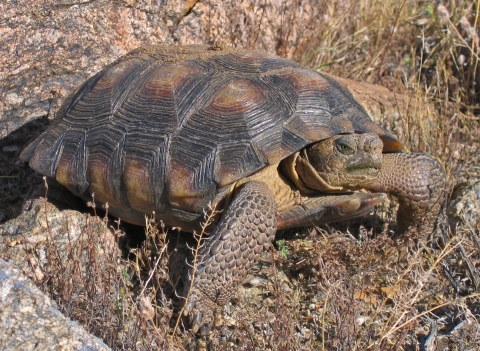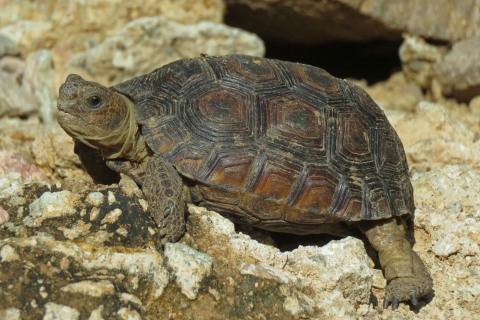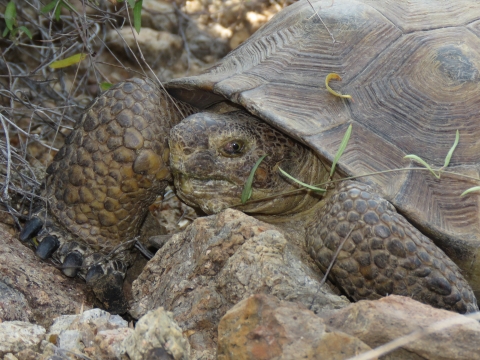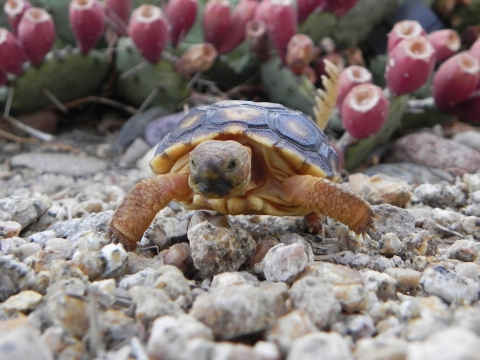It’s hard to find someone who dislikes tortoises. Their occurrence in mythology spans continents, where they symbolize wisdom and stability. Perhaps it’s their calm nature and slow movement. Maybe they remind us of our elders. In the case of the Sonoran Desert tortoise, we even share a similar life cycle: they reach adulthood in their late teens and can live to be 100.
Adapted to Extremes
While popular as pets, they are very much meant for life in the arid wilderness. Found in the Sonoran Desert region of Arizona and northwest Mexico, Sonoran Desert tortoises are well adapted to extremes.
They hatch from a golf-ball sized egg in an underground burrow in September or October. They don’t need to be cared for by adults, but only about 5% of Sonoran Desert tortoise hatchlings survive to adulthood. They’re quite vulnerable, out on their own. They emerge with the rains. Since their shells are soft and they’re so small, most become food for predators or fall victim to dehydration from drought. It takes 16–19 years for them to reach sexual maturity, with their development heavily influenced by the amount of precipitation in their local area.
Their reproduction cycle is also a slow and steady process. Mating for Sonoran Desert tortoises happens at the end of the monsoon season. A female can store sperm for years before laying eggs, as their ability to produce eggs at all depends on if they’ve had enough food and water. Clutch sizes vary from 1–12 eggs, and only about 60% of those will hatch at all.
Very much home bodies, Sonoran Desert tortoises spend 90% of their time in shelter sites. During prolonged drought periods, these reptiles can survive over a year without water. They hibernate in the winter in a brumation state, when their metabolism slows down and they use less of their food and water stores. In the summer, surface temperatures in the Sonoran Desert can soar over 120 degrees, meanwhile, their shelter site temperature could be 40 degrees cooler than the searing heat above.
Threats on the horizon
Unfortunately, tortoises in general are in trouble. Because of their slow-going life cycle, they are especially vulnerable to ecological changes, and it’s difficult for them to bounce back from setbacks. Luckily the Sonoran Desert tortoise’s wild population is still strong enough that it doesn’t require Endangered Species Act protection from the U.S. Fish and Wildlife Service . It currently occupies most of its historical distribution with steady numbers.
That’s not to say they’re invincible. One primary threat comes from introduced invasive grasses, which affect the whole Sonoran Desert ecosystem, such as buffelgrass. Imported from Africa in the 1930s for erosion control, buffelgrass out-competes native plants, and it easily catches fire in areas that aren’t accustomed to flames, destroying important cover such as old-growth cacti and Palo Verde trees. There is some hope in controlling these invasive grasses, by manual removal and herbicide treatments, but whether efforts can be scaled-up to treat large areas remains uncertain.
While Sonoran Desert tortoise numbers remain relatively strong, property development and drought are two causes that are expected to increase over time, and wildlife managers remain vigilant in monitoring tortoise populations.
Interaction with humans is another major concern to the species, and that’s preventable through education.
“’Human interactions’ refers to a myriad of different ways humans affect individual tortoises on the landscape,” said U.S. Fish and Wildlife Service biologist Jeff Servoss. “Pathways for adverse human-tortoise interactions may include vehicle use, target shooting, hunting, hiking, rock crawling, trail bike riding, rock climbing/bouldering, camping, collection, and releasing pet tortoises.”
Released pet tortoises will compete with Sonoran Desert tortoises for resources, introduce disease into wild populations, and they’ll also hybridize, harming the gene pool. People paint tortoise shells, which can irritate them and expose them to predators. Collecting them from the wild, as a pet, is against the law in Arizona and Mexico, as it’s harmful to the species survivability.
Sometimes recreators will simply pick up a tortoise to look at it. As a defense mechanism, tortoises will often void their bladder, or pee, when they’re handled. Sonoran Desert tortoises may rely on stored moisture for over a year during drought, but if they void their bladder because they were handled by a curious person, it can mean a death sentence for them.
There is a time when you may need to help them out. “The quandary is when a tortoise is observed attempting to cross a busy road or highway. Handling is bad, but so is watching it get crushed,” said Servoss. “In these situations, both the Service and the Arizona Game and Fish Department recommend gently seizing the tortoise on each side of the shell, keeping it low to the ground with its plastron (bottom shell) parallel to the ground, and slowly moving it off the roadway in the direction it was going. Moving tortoises off infrequently used dirt roads or two-tracks is more risk than benefit; and therefore unnecessary.”
So, if you see one when you’re out and about, please just observe them, see what they’re up to, but it’s best to leave them be.
Adoption
The collection of wild Sonoran Desert tortoises in the U.S. remains prohibited. However, there’s a surplus of Sonoran Desert tortoises in captivity that need homes as a result of unplanned or unmanaged breeding of captive tortoises. Due primarily to illegal breeding, Arizona Game and Fish Department has more than 100 tortoises of various ages and sizes available for adoption. Captive tortoises grow up to about 14 inches long and can live upward of 100 years. They cannot be released back into the wild, however, because they could spread diseases that harm wild populations Arizona residents interested in adopting a tortoise are encouraged to apply with the Arizona Game and Fish Department.









